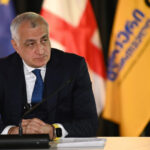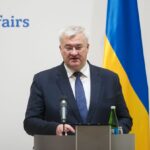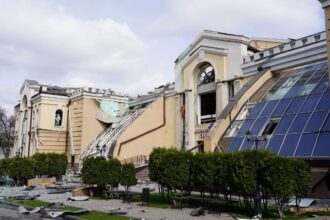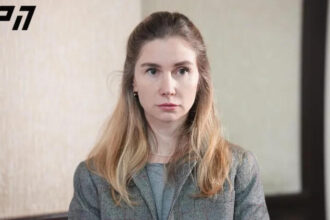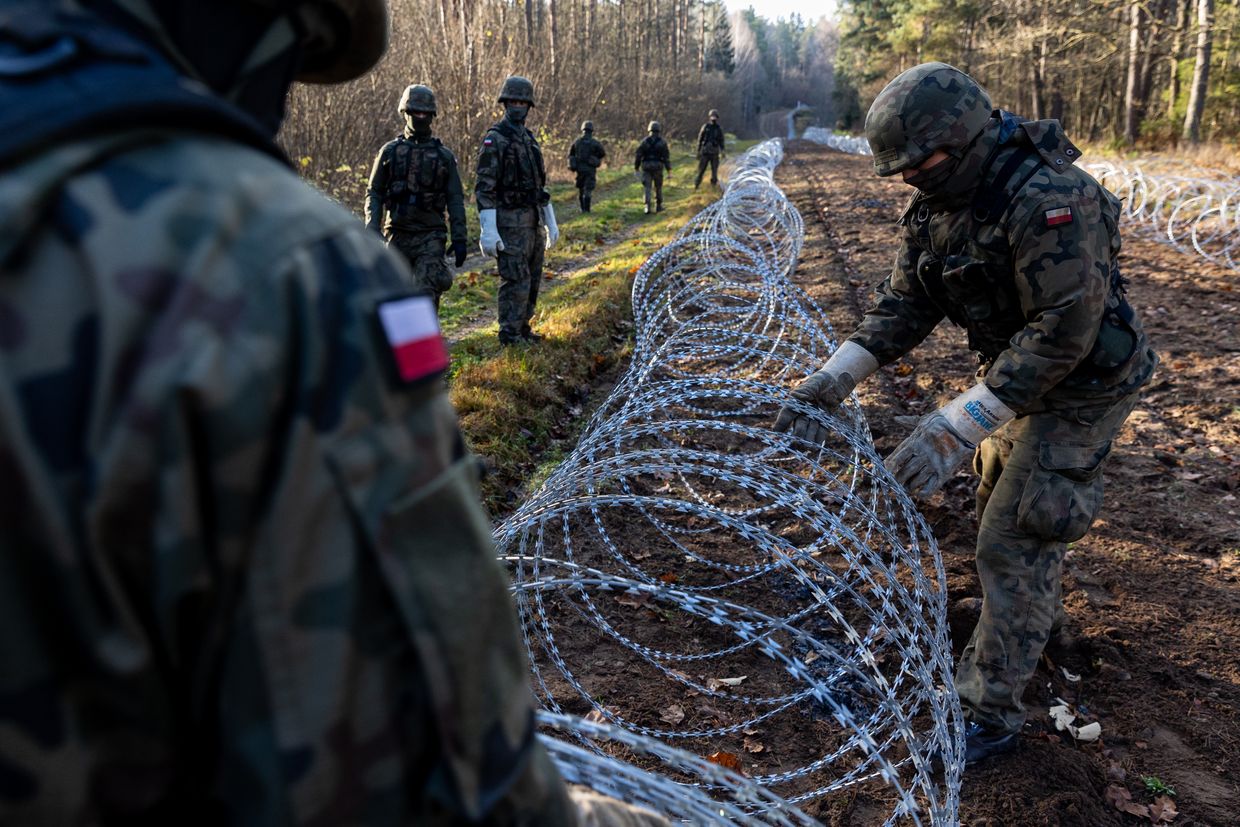(Ulf Mauder/picture alliance via Getty Images) On July 15, 2022, ships anchor in the Russian Baltic Exclave of Kaliningrad. The city was formerly known as Konigsberg. (Ulf Mader/picture Alliance via Getty Images).
This week, Lithuania announced that it had fortified and blocked a bridge across the Nieman River connecting it to the Russian enclave of Kaliningrad. It was the latest in an escalation of tensions in the Baltic Sea Region.
The full-scale Russian invasion of Ukraine has heightened fears of an open conflict between Moscow, Russia’s ally Belarus, and Kaliningrad Oblast. Lithuania, which borders Russia’s ally Belarus, is one of the countries that could be affected by such a clash.
The picture released by Lithuanian Defense Minister Laurynas Kaciunas, on October 9, shows that his country takes the threat seriously. The bridge is now covered with “dragon’s tooth.” He said that other bridges leading towards Kaliningrad will also be fortified and some may be mined.
The announcement was made days after an incident occurred on the Kaliningrad – Moscow railway line. One carriage of a train arrived at the Kena checkpoint at the Lithuanian-Belarusian borders displaying the letter Z, a symbol commonly used by Russian invasion forces in Ukraine.
Another was defaced by an inscription that described Vilnius, the capital of Lithuania, as a “Russian town.”
The Kyiv Independent quoted Dr Stephen Hall, lecturer on Russian and post-Soviet Politics at the University of Bath.
“The Baltics are a region that has a long history as being occupied by foreign forces, notably Russia, but a relatively recent history of independence.”
He says that while he doesn’t “expect to see Russian tanks anytime soon in Riga, Tallinn or Vilnius,” Lithuania and other Baltic States have every right to be worried about what Russia has planned in the exclave on their doorstep.
Kaliningrad Oblast measures 15,100 square kilometers, which is not much bigger than Connecticut in the U.S. It has a small, western coast on the Baltic Sea. Kaliningrad is also the name of its capital.
It may be small but strategically it gives Russia another point of direct access into the Baltic Sea. The other is through its most easterly arm in the Finnish Gulf.
The Baltic Sea Fleet’s headquarters and main base are located in Kaliningrad Oblast. The Russian Admiralty’s headquarters is located in St. Petersburg on the Baltic Sea.
Dr Hall added: “You have a lot of ships there and what’s necessary to defend them.”
According to a report published by the Carnegie Endowment for International Peace in December 2023, the exclave is home to an “awesome” arsenal of weapons, including “cruise-missiles, surface-to air missiles, and nukes.”
But Lithuania’s blocking bridges suggests that the country is not only concerned about the threat of missiles but also a land invasion.
According to Dr Hall the narrow strip of land known as the Suwalki Gap is the main focus of Lithuanian, Latvian and Estonian fears.
The Suwalki Gap marks the closest point to Kaliningrad Oblast and one of Russia’s staunchest friends, Belarus.
The border between Poland and Lithuania is only 40 kilometers wide on the Polish side.
In the event of war between NATO and Russia the Russian and Belarusian troops joining forces across the Suwalki Gap will cut off the only route to the three Baltic States.
Dr Hall said that the Russian army had been training for this since the 1990s.
He says that although the recent NATO memberships by Finland and Sweden have likely changed NATO’s planning for an event of this nature, for many years “the idea among NATO member states was that Lithuania, Latvia and Estonia would have to accept Russian occupation – hopefully for only a short time — as NATO forced their way back up to the Baltic Peninsula.”
Not only the Baltic States are raising alarms about Russian intentions. In May, NATO’s newest member, Sweden issued an ominous message with Micael byden, the supreme command of the Swedish Armed Forces. Byden said that Russian President Vladimir Putin could be seeking dominance in the Baltic Sea, and may have his eye on Gotland, the Swedish island.
Gotland, Sweden’s largest Island, is located around 330 kilometers north of the Russian exclave Kaliningrad. Its central position makes it a strategic island in the Baltic Sea.
Byden said, “Whoever controls Gotland controls Baltic Sea.”
Most analysts and commentators believe that a conflict between Russia and NATO is not imminent. This has been the case since Moscow’s full-scale invasion in Ukraine began in 2022.
Germany’s military has drafted plans for “a Russian conventional attack within five years.” In January, a senior NATO official gave an estimated timeframe of “the next twenty years.”
It could be argued that Lithuania’s decision to block bridges in order to prevent a Russian attack on the ground is premature, given that Russian forces are already present in Ukraine and Russia’s Kursk Oblast.
According to Dr. Jan Kallberg of the Center for European Policy Analysis in Washington D.C. and the Army Cyber Institute at West Point, viewing Lithuania’s actions this way misses out on the point.
“The Lithuanians and Estonians are constantly intimidated by the Russian supremacist government, which is trying to project the idea that these countries or parts of them, in a Russian mind-set, are provinces who have rebelled and must be forced back to Russia,” he said to the Kyiv Independent.
Lithuania was annexed by the Soviet Union along with other Baltic states during World War II. The nation only declared its independence in 1990.
“Mining or blocking border bridges can be a signal that you’re not intimidated and are ready to fight for freedom,” Kallberg says.
Dr Hall is in agreement, stating that the U.S. as well as other European countries would have benefited from adopting a similar approach both before and during Russia’s full-scale invasion into Ukraine.
“It is better to be proactive now and send a strong message in the hope that Russia sees that signal and decides it’s not worthwhile, something that I think Western States have consistently failed to do regarding Putin,” said he.
Even if a Russian invasion on NATO territory is still years away, Kaliningrad has a vital role to play in Russia’s ongoing destabilization efforts.
Moscow has been increasing tensions in Baltic Sea. GPS jamming and disappearing buoys are just some of the recent events that have raised concern about the Kremlin’s intentions in the area.
In recent months, incidents of jamming GPS systems aboard commercial planes over the Baltic Sea have increased. It’s difficult to determine who is responsible, but a jammer can block a signal up to 350 kilometers away from where it is placed.
Russia is the most likely suspect as NATO countries are unlikely to engage in self-sabotage. A jammer located in Kaliningrad could give them the range needed to disrupt flights in this region.
The situation in Kaliningrad and its Western neighbours appears to be heading only one way. With a Russian hybrid war ongoing against the West, and the looming threat of a direct conflict with NATO on the horizon.
Kallberg said that “in the long term, we could see the development of these Baltic and Polish border to Russia and Belarus similar the Korean 38th Parallel between South Korea North Korea.”
“A militarized boundary that is a never ending propaganda battle, using all forms intimidation and propaganda, on and off and even open aggression.”
Chris York is the news editor of the Kyiv Independent. He was the head of news for the Kyiv Post before joining the team. He spent almost a decade in Britain working for HuffPost UK. He holds a MA in Conflict, Development, and Security, from the University of Leeds.
Read More @ kyivindependent.com





